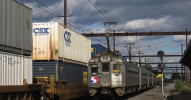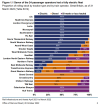shawmat
Member
India has set itself the target of electrifying the entire broad gauge network by 31st March 2024 i.e. to complete within the next 7 months. The nation has been adding 7-10% every year for the last six years, so it looks like the target will be met. Net zero is a 2030 target, which requires the use of green sources of electricity rather than coal.
That's an extraordinary achievement, as least on a par with the moon landing! Indian railways (excluding metros) carry 8.5bn passengers per annum, second only to Japan (25bn), but they make longer journeys (6x). 1.2tn passenger-km is second only to China's 1.5tn with its well developed high-speed network.
The map shows this investment is not replicated in adjacent countries. Even China's line to Lhasa is not yet electrified (but is in progress).

That's an extraordinary achievement, as least on a par with the moon landing! Indian railways (excluding metros) carry 8.5bn passengers per annum, second only to Japan (25bn), but they make longer journeys (6x). 1.2tn passenger-km is second only to China's 1.5tn with its well developed high-speed network.
The map shows this investment is not replicated in adjacent countries. Even China's line to Lhasa is not yet electrified (but is in progress).




